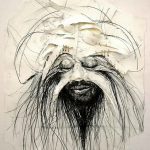Above, Between, Below | March 21- May 3, 2015

Flying North, 93″x44,” batik on silk, 2004, by Mary Edna Fraser
The City of Charleston Office of Cultural Affairs presents Above, Between, Below at the City Gallery at Waterfront Park from March 21 through May 3, 2015, featuring batiks on silk by Mary Edna Fraser. The exhibition, curated by Michael Haga, will open with a reception on Friday, March 20 from 5 to 7 pm. In addition, the public is invited to attend an artist’s talk by Fraser on Saturday, April 18 at 2pm. Both events are free and open to the public.
Above, Between, Below is an ambitious exhibition of work by Lowcountry artist Fraser, depicting through her signature batiks on silk breathtaking perspectives on space, earth, and deep sea. Developed with leading scientists in the fields of planetary science, coastal geology, and oceanography, Above, Between, Below bridges cutting-edge science and the living, ancient art of batik to afford a vantage point the human eye and traditional cameras cannot reveal.
Collaborators Ted Maxwell (Planetary Scientist Emeritus at the Smithsonian National Air and Space Museum), Orrin H. Pilkey (James B. Duke Professor Emeritus of Geology at the Nicholas School of the Environment at Duke University) and Cindy Lee Van Dover (Director of the Duke University Marine Lab) assisted Fraser in developing batiks as a vehicle to share scientific information, to educate, and to inspire. Working closely with these scientists, the artist has drawn upon their scholarship and insights to develop images that can emphasize the fragility of ecosystems or bring the grandeur of distant spaces near to us. Fraser refers to her pieces as “snapshots” in geologic or galactic time and asserts that artists can condense and interpret scientific observations so that viewers may develop a greater understanding of the world that we inhabit as well as other realms.
Curatorial Statement

Kilimanjaro (Tanzania), 34″x 44.5,” batik on silk, by Mary Edna Fraser
Michael W. Haga
Associate Dean, School of the Arts, College of Charleston
There is a well-established tradition of the arts and science coming together in order to bring new discoveries and scientific information to interested audiences. For example, Mark Catesby’s The Natural History of Carolina, Florida and the Bahama Islands, which he published in the opening half of the eighteenth century, was a folio of over 200 etchings illustrating North American species that were new to many Europeans. In the following century John James Audubon’s The Birds of America captured imaginations with vivid depictions of birds tending their young, feeding, contending with predators, and living in varied habitats.
While many cultures have developed processes for using resist methods to dye cloth, the public tends to associate batik with Indonesian fabrics that feature beautiful patterns and color combinations that can dazzle the eye. Contemporary artists, including South Carolina’s Mary Edna Fraser and Leo Twiggs, use this centuries old process in ways that pay homage to an ancient tradition while moving it in new directions.
Fraser’s work brings together these two traditions. Working closely with scientists who are leaders in their fields of study, she draws upon their scholarship and insights to develop images that can emphasize the fragility of ecosystems or bring the grandeur of distant spaces near to us. Fraser relishes her collaborations with these scientists, noting that they “stretch me as an artist, and I like the discussion and intellectual exchange.”
Research for a particular piece may occupy Fraser for as much as a year, and she says that her work illustrates her colleagues’ ideas, especially “as they have expressed them in lectures and in papers.” She refers to her pieces as “snapshots” in geologic or galactic time and asserts that artists can condense and interpret scientific observations so that viewers may develop a greater understanding of the world that we inhabit as well as other realms.
Fraser captures the colors of the locations she depicts but makes them more vibrant than reality to engage the viewers’ attention. Like cartographers of old, Fraser brings subtle details to light with her palette. In Above, Between, Below, primary colors dominate in the batiks that refer to the undersea world, while black appears primarily in those pieces that have astronomical themes. The soft, mossy green that Fraser uses in Charleston Airborne Flooded defines those portions around Charleston that could be under water by the end of this century. In this and other works, Fraser makes potential future outcomes of scientific predictions seem more present than can any number of official reports or warnings.
Above, Between, Below is the first exhibition to bring together in one venue Fraser’s batiks that address cosmic, coastal geographic, and oceanographic themes. Drawing upon her artistic training and current scientific research, she has created a body of work that explores and interprets non-terrestrial worlds, wetlands, and ocean depths. Fraser plays with scale, distance and time in her work, enticing viewers to consider their place within larger systems.
About the Artist – Mary Edna Fraser

Volcanoes, 48″x48,” batik on silk, 2014, by Mary Edna Fraser
Exploring and photographing the terrain, often from the open cockpit of her grandfather’s 1946 Ercoupe vintage plane, Mary Edna Fraser is a contemporary artist specializing in batik on silk. The ancient art form in the hands of a master dyer transcends the vantage point of the human eye.
Fraser’s large-scale batiks on silk reference maps, satellite images and aerial photographs, often given to her by the scientific community. The art crystallizes new insights, portraying the most salient information provided by her collaborators. The resist dyeing process utilizes multiple layers of wax and dye to create intricate designs. This slow, meticulous process of batik is in stark contrast to how vast information is flowing in this century.
Deemed a “pilot with a palette” by Michael Kilian of the Chicago Tribune, Fraser has been collected and exhibited worldwide. Hank Burchard of the Washington Post declared that “the batiks amount to visual poetry.” National Geographic, NASA and the National Academy of Science have featured Fraser’s work, as have Duke Museum of Art and The Museum of the Earth in Ithaca, NY.
Above, Between, Below combines three exhibitions. The Above component has been shown with planetary scientist Ted Maxwell of the Smithsonian National Air and Space Museum’s Center for Earth and Planetary Studies and composer Mark Mercury of Los Angeles. The Between component highlights Fraser’s work with coastal geologist Orrin H. Pilkey, Duke University Professor Emeritus. Below displays Fraser’s newest art for Cindy Lee Van Dover, biological oceanographer and director of Duke Marine Lab, designed while aboard the Woods Hole Research Vessel Atlantis in 2012.
Individual batiks address ground-breaking science of planetary images and distant galaxies, earth geology and the deepest oceans. Fraser is honored by the time each esteemed colleague has contributed to her education, conveying their life’s work.
Fraser lives in Charleston, South Carolina and has a gallery at her James Island Creek studio. For more information, go to www.maryedna.com.
About the Collaborators

Our Galaxy, 114.5″x54.5,” batik on silk, 2013, by Mary Edna Fraser
Ted Maxwell
Planetary Scientist Emeritus at the Smithsonian National Air and Space Museum (NASM), Ted Maxwell, provides text as the viewer experiences silk galaxies and heavenly bodies of the Above section of this exhibition. Ted Maxwell contributed text for From Outer Banks to Outer Space: Silk Batiks exhibited at Emory University, 2004. His scientific knowledge of planetary geology and the cosmos was also essential to the exhibition Mapping the Planets in Silk and Sound, Flaten Museum, St. Olaf College, 2013. He has been a Principal Investigator in several NASA Research Programs and joined the staff in 1976. From 1982 through 1989, Maxwell was Chairman of the Museum’s Center for Earth and Planetary Studies, was Director of the Regional Planetary Image Facility located at NASM, and is a past Chairman of the Planetary Geology Division of the Geological Society of America. From 1989 until 1992, he was Discipline Scientist for NASA’s Planetary Geology and Geophysics Program. 1992 until 1996, he served as the Senior Advisor for Science at NASM, representing the Smithsonian Institution on scientific research in the US Global Change Research Program. Maxwell has continued his planetary research with more than fifty publications in the professional literature and numerous lectures.
Mark Mercury
The music for this exhibition is “On a Falling Planet,” composed by Mark Mercury and featuring an erhu (Chinese violin), played by Yunhe Liang, set against a backdrop of gentle electronic tones. Los Angeles-based composer Mark Mercury works with a blend of contemporary classical and futuristic electronic music, in which traditional orchestral timbres are fused with newly created, synthesized sounds. Noted for an inventive and dramatic style, Mercury’s composing has been heard around the globe. He has released three albums: “The Art of Space,” “Music of the Domes,” and “Music from Cycles of Spheres.” Also to his credit are soundtracks for film, television, animation, modern dance, ballet, and high-tech multimedia planetariums, including Francisco Martinez Dancetheatre’s “Orbital Dances,” “Ring World” for JPL/NASA, and the documentary “A Man Called God” for Pea Jays, Inc. Fraser began collaborating with Mark Mercury in 1999 producing “Cycle of Spheres” at the Old City Jail during Piccolo Spoleto 2001

Charleston Airborne Flooded (SC), 97″x35,” batik on silk, by Mary Edna Fraser
Orrin H. Pilkey
Orrin H. Pilkey is James B. Duke Professor Emeritus of Geology at the Nicholas School of the Environment at Duke University, and Founder and Director Emeritus of the Program for the Study of Developed Shorelines, now based at Western Carolina University. Mary Edna Fraser and Orrin H. Pilkey have collaborated on two critically acclaimed books, A Celebration of the World’s Barrier Islands (Columbia University Press, 2003), and Global Climate Change: A Primer (co-authored by Keith Pilkey, Duke University Press, 2011). Fraser and Pilkey have had over 50 exhibitions together since meeting in 1993. Pilkey first provided text for Aerial Inspirations: Silk Batiks by Mary Edna Fraser in 1994-95 at the Smithsonian National Air and Space Museum, Washington, DC, the museum’s first textile and one-woman exhibition. Pilkey has written and edited many books, including, most recently, The Last Beach (co-authored with J. Andrew G. Cooper), The World’s Beaches (co-authored with Joe Kelley, Bill Neal and Andrew Cooper), The Rising Sea (with Rob Young) and Useless Arithmetic (with Linda Pilkey-Jarvis). Pilkey is the recipient of numerous honors, including the Francis Shepard Medal for excellence in Marine Geology, the Priestley Award for distinguished contributions to research in Coastal Geology, a Lifetime Achievement Award from the North Carolina Coastal Federation, and the Outstanding Public Service Award from the Federal Emergency Management Agency. Mary Edna fondly calls Pilkey “Boss.”
Cindy Lee Van Dover
Cindy Lee Van Dover is a deep-sea biologist with an interest in ocean exploration and the ecology of chemosynthetic ecosystems. A Fulbright Scholar and Fellow of the American Association for the Advancement of Science, Van Dover is Director of the Duke Marine Laboratory in Beaufort, NC. On receiving her PhD in 1989, Van Dover joined the group that operates the deep-diving submersible ALVIN; she was the first female pilot in 1990 and pilot-in-command of 48 dives. As chief Scientist in NSF and NOAA sponsored field programs to deep-sea environments she is a sleuth of the unknown deep oceans that cover most of the planet. Her project, “Art & Science: Envisioning Ocean Depths” brought 6 artists to sea with 18 scientists on the Research Vessel Atlantis for an expedition that used the tethered Remotely Operated Vehicle JASON to explore mud volcanoes of the Barbados accretionary wedge. Mary Edna was one of the artists challenged to create work that captures the exhilaration of discovery. Through batik, watercolor, music, digital art, cartoon, and experimental video, artists on board created a portfolio that communicates the human experience of exploring the deep ocean. Van Dover met Fraser in 2001 at the artist’s studio and they were excited to work together. The video edited by Celie Dailey, Exploring Deep Sea Volcanoes off the Coast of Barbados: An Artist’s Perspective, is a documentary of their collaboration.

